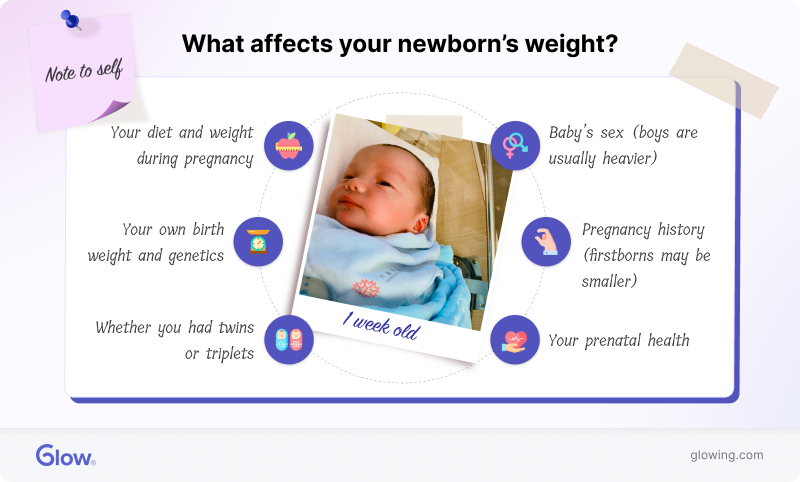Baby Month by Month
1-Week-Old Baby
Your baby just made his grand entrance. Congratulations!

Both you and your baby are adjusting to your new life together as he transitions from the cozy confines of your womb to the bright, bustling world (and you adjust to sleepless nights and mountains of diapers).
Learn what awaits you with a 1-week old baby.
The "newborn look" and what to expect from your baby
Did someone say “raisin”? Don’t worry if your newborn is still a bit puffy-eyed, wrinkly, or has a slightly cone-shaped head—these are all normal effects of his journey through the birth canal and, before that, his snug stay in your uterus. Rest assured, this “newborn look” is temporary and will fade as the weeks progress.
Building a bond with your baby
These early days are the perfect opportunity to build a strong bond with your baby through cuddles, feedings, and lots of skin-to-skin contact.
If you’re already obsessed with your little bundle of joy and can barely remember life without him, that’s great. However, not all recent moms feel that way right off the bat. If you’re in the latter camp, that’s fine; feelings of love and attachment don’t always come instantly. They often develop over time as you get to know your new baby.
Your baby’s development this week
Though he’s barely been out of the womb, your baby has already gone through several body changes and developed essential skills.
Here’s a look at everything big that’s going on with him in his first week:
Skills and reflexes
- Head lifting: This is a small but significant feat. Your baby can lift his head briefly when he’s placed on his tummy. 1
- Visual focus: He can focus on high-contrast objects 8 to 10 inches away (which just so happens to be the perfect distance to gaze into your face). 2
- Rooting reflex: When you stroke the corner of his mouth, he’ll turn his head in that direction to look for a nipple to nurse from. 3
- Moro reflex: This is also called the “startle” reflex. Your baby might throw his arms out and then quickly bring them back in as a result of a sudden noise or movement. 3
- Sucking reflex: This is your baby’s innate ability to suck liquid, which he needs to breastfeed or bottle-feed. 3
- Babinski reflex: Also known as the plantar reflex, this causes your baby’s big toe to bend upwards while the others fan out if you stroke the sole of his feet. Having this reflex shows that signals from your baby’s brain are being transmitted effectively.
Body
- Hair: Your baby may still have some of his lanugo—the fine, downy baby hair that kept him warm and protected during your pregnancy. A lot of babies lose their hair before they’re born, but if your little one still has his, it will fall out soon. As for his first head of hair, it may change in texture and color. 4
- Genitals: Don’t panic if you notice a little swelling in a baby boy’s scrotum or a baby girl’s labia—it’s normal, thanks to your hormones still circulating in your baby’s body. This won’t last for much longer. 5
- Umbilical cord: Your baby likely still has his umbilical cord, which will probably fall off on its own within one to three weeks. Make sure you keep the area dry and don’t pick at it. If you notice redness at the base, a foul odor, or pus on his umbilical cord, speak to your baby’s pediatrician. 6
- Epstein pearls: If you see little white spots on your baby’s gum line or the roof of his mouth, don’t worry; they’re probably just Epstein pearls. These are small cysts made of keratin (a protein found in skin, hair, and nails). They’re normal and usually harmless, and should disappear on their own in a few weeks.
- Moles: If you spot a mole on your baby, try not to worry too much. Most congenital nevi (moles your baby is born with or develops during infancy) are harmless. Still, keep an eye on it, and if it’s unusually large, asymmetrical, or has a mix of colors, bring it up with your doctor.
- Baby acne: Your little one may experience breakouts of acne around his cheeks, nose, and forehead (even sometimes on his back, scalp, neck, and chest). This condition is usually harmless, and should resolve by the time your baby’s 4 months old to 6 months old.
Why your baby is sleeping so much
Don’t worry if your baby spends much of the day dozing. Newborns sleep a lot—around 16 hours a day, in two- to three-hour stretches. (Jealous?) 7
He needs time to recover from the marathon of being born. Take advantage of these quiet moments to get some much-needed rest while he’s resting. After all, you’ve been through a lot, too!
Understanding newborn jaundice
You might notice your baby’s skin is a little yellow. This is known as jaundice, a common condition that affects about 60% of full-term newborns and 80% of preemies (premature babies). 8
It usually appears two to three days after birth and clears up around 10 days after birth, although it sometimes takes longer in preemies and breastfed babies. Jaundice often appears on the face first, then spreads to the rest of the body, including the whites of the eyes.
To check for jaundice, put your baby in natural light and press gently on his forehead and nose. You can also check the palms and soles of his feet. If his skin appears yellowish, consult your pediatrician. They may perform a blood test to check his levels of bilirubin (the byproduct of your baby’s broken-down old red blood cells). 9
If you do notice jaundice in your little one, don’t panic. In most cases, it resolves on its own or with minimal treatment, although your doctor will confirm this and tell you exactly what to do.
Your baby’s growth and health in the first week
Since he’s so tiny and new to the world, your newborn is vulnerable. You’ll need to keep an eye on his health and development, and he’ll need to get checked over by his pediatrician, too.
Here’s everything you need to do this week:
Track your newborn’s growth
Newborns weigh around 7 pounds, on average, and measure just under 20 inches long at birth. 10
All babies lose a little weight during their first few days, and sometimes more than a little; your baby may shed as much as 10% of his birth weight. 10 This is usually normal. He’s just getting rid of the excess fluid he accumulated in the womb. 1

What else affects your newborn’s weight?
Several factors can influence your newborn’s weight, including:
- Your weight and diet during pregnancy
- Your prenatal health
- Your own birth weight and genetics
- The baby’s sex (boys tend to be slightly heavier)
- Whether this is your firstborn (firstborns tend to be smaller)
- If your baby is a twin or triplet (unsurprisingly, multiples often weigh less)
Don’t be alarmed if your baby weighs a little more or less than average. Your pediatrician will let you know if he’s far enough away from the norm for it to be a concern and what you should do if he is.
Attend your baby’s health visits
Your hospital or birthing center will carefully monitor your newborn’s health this week. Here are some of the essential health checks and procedures you can expect: 11
- Apgar score: Immediately after birth, your baby will be assessed and given an Apgar score, which evaluates his appearance, pulse, reflexes, muscle tone, and breathing. 12
- Vitamin K injection: Your baby will receive a vitamin K injection to support his blood clotting ability. 13 This is a very important shot, so make getting it done a priority.
- Hepatitis B (HBV) vaccine: If he didn’t get it right away when he was born, your doctor will probably administer your baby’s HBV vaccine this week.
- Newborn screenings: These include tests for metabolic and hormonal disorders, congenital heart disease, and hearing.
- Well-baby visit: Your baby’s first pediatrician appointment, usually scheduled within a week of birth, will involve a full checkup.
How to look after your 1-week-old baby
If you’re a first-time parent, you might be intimidated by the thought of caring for a fragile newborn. Try not to be—billions of parents have managed it before you, and you’ll do just fine.
Here’s what you need to know about your baby’s care.
Feeding your newborn
Somebody has worked up quite the appetite! Whether you’re breastfeeding or bottle-feeding, make sure your baby gets enough milk.
If you’re bottle-feeding, try out different baby bottles and nipple flows, and experiment to find comfortable positions for both you and your baby. If you’re breastfeeding, know that it can take time to establish a good milk supply. Feeding on demand is the best way to stimulate your milk production.
A 1-week-old baby should eat about 1 to 2 ounces every 2 to 3 hours. 14 If yours falls asleep during feedings, try to keep him awake by stroking his face or changing his diaper. The American Academy of Pediatrics (AAP) also recommends that all breastfed babies receive 400 IU of supplemental vitamin D daily. 15
Safest sleeping position
Make sure your baby sleeps on a firm surface with nothing else in his crib. Always place him on his back, as it’s the safest sleeping position for infants. 16
You should avoid sharing a bed with your baby for the first 6 months for the very same reason. As tempting as it might be, it just isn’t safe. 17
Learning how to swaddle your baby can also be a game changer for his sleep, but ensure his swaddle isn’t too tight around the hips and that there’s no loose fabric. 18
Diaper changing
It’s normal for your baby’s poop to turn yellow, green, or brown after the first couple of days (although the very first poop, which consists of a substance called meconium, is black and tarry).
For the first few days, 3 wet diapers per day is a good sign he’s getting enough milk. After that, you should expect around 6 wet diapers a day. 19
When it comes to poop—every parent’s favorite subject—note that some babies poop after every feeding, while others only do so once every few days. Both are perfectly normal.
Taking your baby outside
It’s a big world out there, and you’re probably excited to show it all to your newborn baby. However, considering how vulnerable your little one is at this stage, taking your baby outside isn’t as simple as it sounds.
Ultimately, it’s up to you when you start doing this, but use common sense and avoid taking him to crowded places until he’s vaccinated. 20
Bathing your baby
Who doesn’t love bathtime? However, you might want to hold off on filling the tub for now. Until his umbilical cord falls off, which usually happens during week 2, you’ll be able to keep him clean with sponge baths.
In case you’re wondering how often to bathe your newborn, the answer is three times a week until his first birthday. More frequent baths can damage his skin.
Setting boundaries with visitors
Though you’re probably excited to show off your child to the world, do so with caution. Set boundaries with visitors and make sure they wash their hands before touching your baby. Also, make sure that anyone who’s going to be in close contact with him has an up-to-date Tdap vaccine, too (you should have already gotten a Tdap shot during your pregnancy). 21
How to manage the postpartum period
The postpartum period isn’t without its share of challenges. Here are a few tips on how to manage it.
Your postpartum body
After giving birth, your body might look quite different. Be prepared for:
Your first postpartum poop
Your first bowel movement after delivery may feel different than usual. After all, your stomach muscles are still recovering.
You might have your first poop the same day as delivery or a day later. If you had a C-section, it might take a little longer (potentially 2–4 days due to the effects of surgical anesthesia and pain medication, which slow down the bowels). Some women even have to contend with constipation post-delivery. 22
Add plenty of fiber to your postpartum diet, stay hydrated, and do low-stress exercise like gentle walking. You can always look into stool softeners, too.
Puffy and bloodshot eyes
After pushing during labor, you may get bruised or bloodshot eyes. Fortunately, this is only temporary, so you just have to wait it out. You may also get some puffiness due to fatigue and fluid retention. Cold compresses, tea bags, or eye gels can help, along with rest. 23
Swelling
As well as your eyes, the rest of your body may be puffy after delivery. But don’t worry—this won’t last forever. Most swelling eases up after a week.
One word of warning. While a little postpartum swelling is normal, severe swelling can also be a sign of postpartum preeclampsia, especially if you have it alongside other symptoms like: 24
- Severe, debilitating headaches
- Sudden weight gain (more than two or three pounds in one week)
- Nausea or vomiting
- Blurry vision or flashing lights
- Shortness of breath
- Foaming of your urine
If you suspect you might have preeclampsia, get in touch with your doctor right away, as this condition can be life-threatening to both you and your baby when left untreated.
Breast engorgement
As your milk comes in, you may find that your breasts swell or feel unusually hard. This can be uncomfortable, but it will also probably subside on its own after about 7–10 days. 2526
It can take up to 24 hours for you to start producing colostrum (your first, nutrient-rich milk). First-time moms may take up to 4 to 5 days to produce breast milk.
Postpartum weight loss
While you may be eager to get back to your pre-pregnancy weight, remember that your body has been through a lot.
Now isn’t the time to frantically worry about your postpartum weight loss, especially if you’re breastfeeding your baby. Instead, focus on eating healthy and nutritious meals and giving your body time to recover from the marathon of pregnancy, labor, and delivery.
If you’re concerned about getting back to your normal weight, chat with your doctor during your next postpartum checkup.
Build confidence as a parent
No one’s born a natural parent. All moms, even experienced ones, go through moments of doubt and exhaustion.
Cut yourself some slack, rest when you can, and give yourself time to adjust to your new life. You’ll find that the everyday challenges of taking care of your little one get easier with time, and you’ll develop your own rhythm.
If you need a little extra help keeping track of everything going on, consider using a diary or baby tracker app to stay on top of things. The best baby trackers also provide tips and educational content to help you care for your baby.
Take care of your mental health
It’s not just the stress and physical strain on your body that can be challenging. It’s normal to have baby blues after giving birth to your little one—about 80% of mothers get it. If you experience severe anxiety or sadness for more than two weeks, you could be suffering from postpartum depression. Alternatively, if you find yourself constantly and irrationally angry, it could be postpartum rage. Either way, speak with your doctor.
Final thoughts
As you enter the first week of your baby’s life, remember to celebrate—all that hard work you put into your pregnancy has paid off, and you and your little one get to start a whole new life together.
Sure, it won’t all be smooth sailing (say goodbye to that sleep schedule), but one look at your adorable little raisin is proof enough that it’s worth it. Welcome to parenthood!
Article Sources
- Lurie Children's. "Your Newborn’s First 2 Weeks of Life: 10 Things to Expect" Retrieved July 16, 2025.
- American Optometric Association. "Infant Vision: Birth to 24 Months of Age" Retrieved July 16, 2025.
- Stanford Medicine Children’s Health. "Newborn Reflexes" Retrieved July 16, 2025.
- Cary OB/GYN. "Why Newborns May Appear Hairy: Lanugo and Newborn Hair Growth" Retrieved July 16, 2025.
- Nemours KidsHealth. "Getting to Know Your Newborn" Retrieved July 16, 2025.
- Seattle Children’s Hospital. "Umbilical Cord Symptoms" Retrieved July 16, 2025.
- Stanford Medicine Children’s Health. "Newborn Sleep Patterns" Retrieved July 16, 2025.
- Children’s Liver Disease Foundation. "Jaundice in the newborn baby" Retrieved July 16, 2025.
- National Health Service. "Diagnosis" Retrieved July 16, 2025.
- University of Rochester Medical Center. "Newborn Measurements" Retrieved July 16, 2025.
- American Academy of Pediatrics. "1st Week Checkup Checklist: 3 to 5 days old" Retrieved July 16, 2025.
- Nemours KidsHealth. "What Is the Apgar Score?" Retrieved July 16, 2025.
- American Academy of Pediatrics. "Why Your Newborn Needs a Vitamin K Shot" Retrieved July 16, 2025.
- American Academy of Pediatrics. "How Often and How Much Should Your Baby Eat?" Retrieved July 16, 2025.
- Pediatrics (2008). "Prevention of Rickets and Vitamin D Deficiency in Infants, Children, and Adolescents" Retrieved July 16, 2025.
- National Health Service. "Reduce the risk of sudden infant death syndrome (SIDS)" Retrieved July 16, 2025.
- Pediatrics (2016). "SIDS and Other Sleep-Related Infant Deaths: Evidence Base for 2016 Updated Recommendations for a Safe Infant Sleeping Environment" Retrieved July 16, 2025.
- American Academy of Pediatrics. "Swaddling: Is it Safe for Your Baby?" Retrieved July 16, 2025.
- MyHealth.Alberta.ca. "Signs That Your Baby Is Getting Enough to Eat" Retrieved July 16, 2025.
- Nemours KidsHealth. "When Can I Take My Newborn Out in Public?" Retrieved July 16, 2025.
- Johns Hopkins Medicine. "New Parents and Newborns: Are Visitors OK?" Retrieved July 16, 2025.
- Cleveland Clinic. "What To Know About Pooping After Giving Birth" Retrieved July 16, 2025.
- Kaiser Permanente. "Postpartum Recovery and Coping" Retrieved July 16, 2025.
- The Society for Maternal-Fetal Medicine’s (SMFM). "Warning Signs of Postpartum Complications" Retrieved July 16, 2025.
- The Children's Hospital of Philadelphia. "Breast Engorgement" Retrieved July 16, 2025.
- Mount Sinai. "Timing of breastfeeding" Retrieved July 16, 2025.







